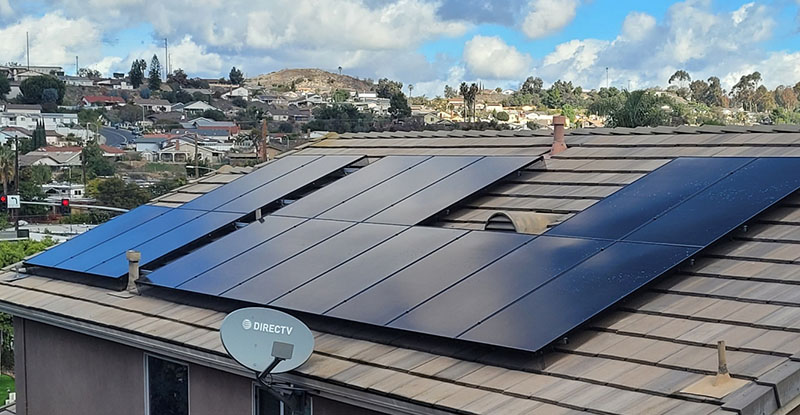
As climate change rears its head, the world is in desperate need of clean and renewable energy sources. Photovoltaic (PV) solar is now the fastest growing energy source, which is good news for people that like cheap, clean, and renewable energy.
In this article, we’ll explore how solar energy works, what makes it renewable, and how it benefits the environment.
Let’s dive in with a quick recap of how solar energy works.
How does solar energy work?
Solar energy is generated by capturing the sun’s energy and turning it into electricity for your home or business. The process can be broken down into five basic steps.
Five steps of solar energy
- Solar panels made up of photovoltaic (PV) cells are installed on your roof or a separate structure, such as an accessory dwelling unit (ADU) or ground-mounted solar panel array
- When sunlight hits the PV cells, it knocks electrons loose from the atoms they are bound to, creating a flow of electricity
- The solar panels are connected to an inverter, which converts the direct current (DC) electricity produced by the panels alternating current (AC) electricity — the type of electricity that is used in your home
- The AC electricity is then sent to your home, where it powers your lights, appliances, and other electrical devices
- Any excess solar energy that is generated is stored in a battery or pushed onto the grid, where it can be used by nearby electrical systems
Obviously, solar energy requires sunshine and only works during the day. Many home solar systems are grid-connected and use net metering to earn credit for excess electricity. Others use battery storage to bank energy for nights and power outages.
Is solar energy renewable?
Yes, solar energy is a renewable energy source. Renewable energy sources are those that can be replenished naturally and are not depleted when used. They include:
- Solar
- Wind
- Water (hydroelectric and tidal)
- Geothermal
The sun is an abundant and virtually limitless source of energy, and as long as the sun continues to shine, we will be able to generate solar energy.
In fact, the National Oceanic and Atmospheric Administration (NOAA) found that “solar energy is the most abundant energy resource on earth — 173,000 terawatts of solar energy strikes the Earth continuously. That’s more than 10,000 times the world’s total energy use.”
There’s more than enough solar energy to go around – we just need to catch, store, and distribute it!
In contrast, nonrenewable energy sources are finite, meaning they can be depleted if we continue to use them at the current rate. These include fossil fuels such as coal, oil, and natural gas, which are formed over millions of years from the remains of plants and animals.
Related reading: The Pros and Cons of Going Solar
What makes solar the primary source for renewable energy?
Solar is sometimes referred to as the primary renewable energy source because it is the most abundant, cost effective, and widely available source of renewable energy on the planet.
In addition to being renewable and widely available, solar energy is also a clean and environmentally-friendly source of energy. It does not produce any emissions when generating electricity, and the emission generated to manufacture a solar panel are typically offset within 2-3 years.
It’s no surprise, then, that solar capacity is growing faster than any other energy source – renewable or not. Utility-scale solar accounted for 35% of all energy generation installed from January to September 2022, followed by wind and natural gas.
And solar is just getting started.
From October 2023-September 2025, there are nearly 72 GW of “high probability additions” of solar lined up, which would make up 65% of all new generation capacity.
Likely energy generation additions for Oct. 2023 to Sept. 2025
| Energy source | High probability additions (GW) | Scheduled retirements (GW) |
| Solar | 71.6 | 0 |
| Wind | 18.3 | 0.14 |
| Natural gas | 17.1 | 17.5 |
| Nuclear | 2.2 | 2.3 |
Data: US Federal Energy Regulatory Commission (FERC)
How does solar energy benefit the environment?
Solar energy is both a renewable and sustainable energy source because it meets the needs of the present without compromising the ability of future generations to meet their own needs.
There are several ways that solar energy benefits the environment.
Solar reduce carbon emissions
Primarily, using renewable solar energy can benefit the environment by reducing our reliance on fossil fuels, which contribute to climate change. By using solar energy, we can reduce the amount of planet-warming gasses in the atmosphere and help to preserve the planet for future generations.
Solar energy conserves water
Solar energy not only reduces carbon emissions, it also conserves water.
All sources of electricity generation require water. However, whereas water use is continuous for fossil fuels and nuclear electricity gneeration, solar panels only need water during manufacturing. Once installed, solar panels require zero water. That leaves 25+ years of water-free energy production.
A 2022 study by professors Avner Vengosh and Erika Weinthal at Duke University’s Nicholas School of Environment found that the water savings potential of solar is enormous.
“Converting to solar in homes reduces the use of the grid electricity and therefore also the volume of water. In some states, like in the southwestern U.S., the individual household water saving can reach up to 1000 percent upon installing rooftop solar.”
Solar panels can also be used to shade canals and bodies of water to reduce evaporation. In fact, covering California’s 4,000 miles of canals with solar panels would save more than 65 billion gallons of water per year.
Rooftop solar preserves land
In addition to emissions and water, solar energy can also reduce virgin land use. Rooftop solar, in particular, requires zero extra land and turns a surface that absorbs heat into one that generates clean electricity.
Solar panels can also be used in conjunction with agricultural and native landscapes in a system known as “agrivoltaics.”
Pairing solar panels with agriculture has the potential to:
- Enhance crop yields and native plant growth
- Shelter livestock and wildlife
- Reduce water loss to evaporation
- Provide a secondary source of income for farmers and ranchers
- Preserve wildlands
Agrivoltaics is one of many examples of the versatility of solar energy.
Anyone can produce renewable solar energy
Perhaps the coolest thing about renewable solar energy is that the general public can produce it!
Rooftop solar is not only incredibly beneficial to the environment – it’s good for your pocketbook. Going solar can lower your energy costs and provide a predictable monthly payment. Over the 25-year warrantied life of a solar system, this can add up to tens of thousands of dollars in energy cost savings.
As the primary renewable energy, rooftop solar is truly a win-win. Connect with an Energy Advisor to compare multiple quotes from vetted solar installers.







